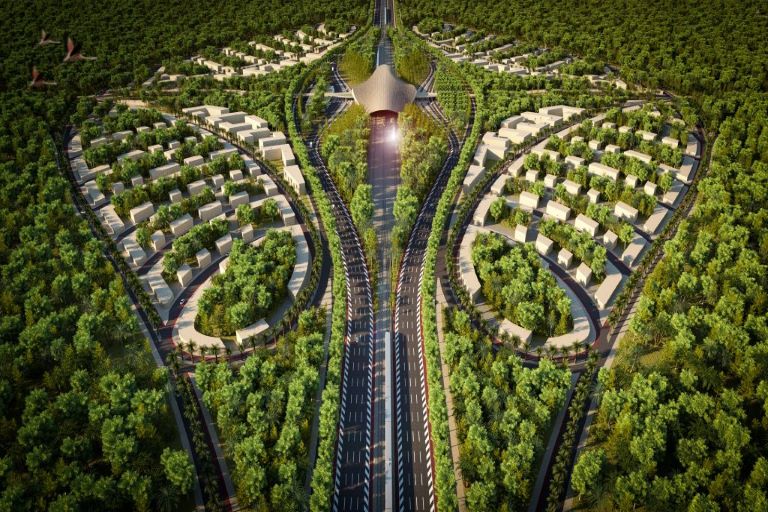- The nearly $15 billion Tren Maya railway will run 1,500 kilometers (950 miles) across five states in Mexico: Quintana Roo, Campeche, Chiapas, Tabasco and Yucatán.
- Line 5 of the project, which will run between Cancún and Playa del Carmen, poses a serious threat to local ecosystems and subterranean habitats, according to injunctions filed in a federal court.
- In July and August, a judge began lifting suspensions on the project, claiming it met the environmental and legal standards to continue.
A major section of Mexico’s Tren Maya railway line could be moving forward with construction, following a high court decision to reject several legal challenges that had created months of delays for the project.
Line 5 of the Tren Maya project, which will run through Cancún, Tulum and Playa del Carmen, poses a serious threat to local ecosystems and subterranean habitats, according to injunctions filed against the project. But most of those concerns have now been rejected by a federal judge, bringing construction closer to realization.
“Line 5 doesn’t comply with environmental standards,” said Gerardo Ceballos, a researcher at the Ecological Institute at the National Autonomous University of Mexico (UNAM). “The environmental impact assessment studies have a lot of problems. It doesn’t evaluate alternative routes to minimize severe environmental impacts. There are many studies that tell us that this puts the environment at risk, and it puts the construction of the train at risk, too.”
The nearly $15 billion Tren Maya line will run 1,500 kilometers (950 miles) across five states — Quintana Roo, Campeche, Chiapas, Tabasco and Yucatán — with 21 stations. The project is broken up into seven lines, nearly all of which have been criticized by conservationists and human rights advocates, who say President Andrés Manuel López Obrador (commonly known by his acronym of AMLO) is rushing the project.
On Line 5, the main complaint made in the injunctions was that proper environmental studies, which evaluate how construction will impact the surrounding habitats, were not carried out.

“When things are done in a hurry and they’re done out of a commitment to a political interest rather than an interest in serving the community and sustainable use, then things happen as they are happening,” said Rodrigo Medellin, another researcher at UNAM’s Ecological Institute.
In late May, a federal judge temporarily suspended construction of Line 5 following the injunctions. Despite the suspension still being in place in July, construction resumed because the government declared the line a matter of national security — a strategy it’s taken with many of its most important infrastructure mega projects.
In late July and early August, the judge started lifting the suspensions after environmental studies were carried out. However, critics of the project say there are major gaps in the studies that leave some parts of the environment vulnerable. The judge also said there was no way to review whether the government broke the law by working during the suspension.
“The work has always been legal, but we met all the judge’s requirements to leave no doubt,” Javier May, the general director of Mexico’s tourism board, Fonatur, tweeted after the first injunctions were removed. The tourism board is one of the key backers of the project.
Right now, five of the six injunctions that have been filed against Line 5 have been revoked. Once the final injunction is revoked, construction will be able to continue completely free of legal constraints.

Quintana Roo, which Line 5 will traverse, has experienced some of the highest rates of deforestation in Mexico in the past two decades, according to a 2020 Mexico Forest Commission (Conafur) report. The train could exacerbate habitat fragmentation in the area, threatening some of the densest jaguar populations in the country.
The area also sits on porous limestone terrain with caves, cenotes and underground rivers that sustain subterranean ecosystems. Indigenous Maya communities have managed to keep these unique ecosystems alive for centuries. But the construction of the train line could destroy a lot of that rock and the wildlife below it, several conservationists told Mongabay.
They’re especially worried about the millions of bats that sleep in the caves during the day and come out at night to hunt insects, which would otherwise overwhelm food crops, cotton and other agricultural products.
“Any day of your life, you have been affected by bats,” Medellin said. “If you have a coffee in the morning, you owe it to the bats. If you wear your favorite jeans, you owe it to the bats. If you eat tacos or tamales or any corn product, you are connected to the bats. They are putting at risk the wonder that bats are as pest controllers. Not to mention their service as seed and pollination dispersers.”
The destruction of the underground ecosystems could also hurt the local economy, as many communities rely on ecotourism, such as guided visits to cenotes and caves, for their livelihoods. Even more worrisome, the underground systems are a source of drinking water that the train line could contaminate, if not interrupt entirely.
“They’ve encountered all of these obstacles throughout construction,” said Otto Von Bertrab, a conservationist and cave diver, “and what keeps happening? They continue anyway. They are going to leave us with what’s left of the jungles of Playa del Carmen, abandoned and devastated.”
Banner image: Preliminary designs of the Maya Train in Quintana Roo. (Courtesy of Fonatur).
Hear this reporter discuss Tren Maya on Mongabay’s podcast, listen here:
FEEDBACK: Use this form to send a message to the author of this post. If you want to post a public comment, you can do that at the bottom of the page.














